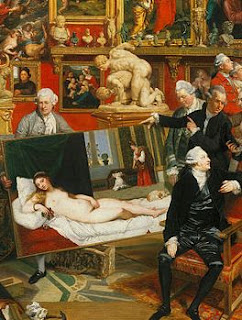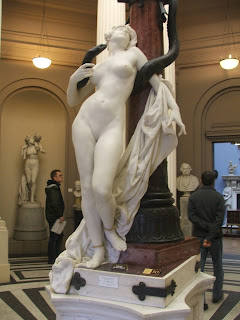UNCLE MONTY, DJANGO & THE WRESTLERS
UNCLE MONTY, DJANGO &THE WRESTLERS
One of my sadder hobbies (OK, I admit that I do jigsaws and
Sudoku as well) is spotting appearances of Classical statues in unexpected
contexts: advertising, films, television game shows. Classical statues are used as a form of
visual shorthand to convey a message or an atmosphere – for example, the casts
of Riace Warrior A in Celebrity Juice
are presumably intended to convey ‘decadence’, or at least a Carry On-style naughtiness. In other modern contexts, Classical sculptures
have been used to convey everything from beauty, purity and civilised ‘good
taste’ to sexual licence, narcissism, paganism or even fascism. In this article I’m going to explore how one
particular ancient sculpture – the Wrestlers
- has been used as a piece of set-dressing to create very different messages in
two popular films, Withnail & I
and Django Unchained.
Copy of the Wrestlers in the Hancock Museum, Newcastle
The Wrestlers, now
in the Uffizi Gallery in Florence
One of my favourite scenes in Withnail & I (Bruce Robinson, 1987) takes place in Uncle
Monty’s house in Chelsea , where Withnail attempts
to sweet-talk Monty into lending him his cottage in the Lake
District . Just in case
Monty’s exposition about flowers (‘tarts for the bees’) and carrots has left us
in any doubt about his sexual preferences, check out the statuette on the table
behind the sofa. It’s a miniature
version of the Wrestlers – two naked
men engaged in a well-oiled clinch. This
scene was shot in the home of Bernard Nevill, formerly the director of design
at Liberty
The Wrestlers statue
serves a completely different purpose in Quentin Tarantino’s Django Unchained (2012), in the scene
where Calvin Candie, played by Leonardo di Caprio, is seeking to purchase a
slave to use as a Mandingo fighter.
Leaving aside the historical question of whether Mandingo fighting (in
the sense of bare-knuckle bouts to the death between two slaves) ever really
existed, or was a product of a 1950s novel and a 1975 film (Max Evry, ‘Django
Unexplained’, 2012), the presence of the statue in this scene suggests an
cynical attempt by Candie to elevate his sordid exploitation of his slaves into
a civilised ‘sport’, petrified in marble and thus given the implicit approval
of antiquity. Calvin Candie sees himself
as a ‘Southern gentleman’, but his polished manners and elegant tailoring are
just a veneer covering his brutality – and of course his ‘Greek’ statue is just
a copy of a copy.
The original Greek pankatriasts
in the statue were athletes competing in the Olympic Games. If you killed your opponent while competing
in the pankration it’s likely that
you would have been disqualified; here, however, the Wrestlers are being used by Candie to justify forcing enslaved people to
fight to the death for their owners’ entertainment. However, a further layer of nuance is added
by the fact that the Roman copy of the statue – on which Candie’s copy is based
- was the product of a society which was only too comfortable with the idea of
having enslaved gladiators fighting to the death to entertain an audience.
Wrestlers Statue at World of Glass, St Helens
The History of the
Statue
The Wrestlers
statue was discovered in a vineyard on the Esquiline Hill in Rome Capitoline Museum ,
Rome
Within a couple of months of its discovery, the Wrestlers was acquired by Cardinal Ferdinando
de’Medici, to add to his sculpture collection at his villa on the Pincian
Hill. He also organised the restoration
of the sculpture, the original condition of which can be seen from a print in
one of the albums of antique statues at Rome
Cavalleriis captioned his print as filii Niobes luctantes – ‘the
sons of Niobe wrestling’, showing that in the 16th century the
wrestlers were still assumed to belong to the group of Niobe and her children being attacked
by Apollo and Artemis. In Ovid’s version
of the story, two of Niobe’s sons, Phaedimus and Tantalus, were shot by Apollo
while they were wrestling. However, by
the mid-17th century this theory had fallen out of fashion, possibly
because the Wrestlers had been moved to Florence ,
whereas the Niobids remained in Rome
Although it was originally assumed that the Wrestlers was a Greek statue, by the
early 19th century it was generally accepted that, like most of the
other celebrated statues in Rome and Florence, it was in fact a Roman copy of a
lost Greek original. It’s now usually
assumed to be a 1st century AD Roman marble copy of a lost 3rd
century bronze Greek original.
Who made the original
Greek statue?
As usual, attempts have been made to give an attribution to
this statue by comparing it to descriptions in the work of ancient
authors. Pliny the Elder (uncle of the
Plinster, if you recall) includes ‘pankratiasts’
on his list of statues made by Myron, sculptor of the Discobolos (Discus-thrower). However, most modern authorities agree that
the statue is considerably later than the mid-5th century, when
Myron was working. A more popular
suggestion, on the basis of another brief passage in Pliny’s Natural History, is that the Wrestlers could have been made by
Kephisodotos, son of Praxiteles (that is, the grandson of the Kephisodotos who
made Eirene & Ploutos, or ‘Peace & Wealth’). Pliny says that ‘Kephisodotos’s Symplegma at Pergamon is much praised, a work
distinguished for the way the fingers seem to press on flesh rather than
marble’. A symplegma is the Greek
term used for a group of intertwined figures, which could perhaps apply to the Wrestlers. It has also been suggested that the statue
might have been made by a pupil or follower of Lysippos (Alexander the Great’s
favourite sculptor, who made the Apoxyomenos or ‘Scraper’), an attribution
currently preferred by the Uffizi.
The Influence of the
Statue
Once the statue was installed in the Villa Medici at Rome Rome with minimal fuss, there was much consternation when
it was revealed that they had been moved to Florence ;
there were even rumours that the Pope had been tricked into allowing them to
leave Rome
The three statues, set against a backdrop of Old Master
paintings, were installed in the Tribuna, a hexagonal room within the Uffizi
Palace, a layout we can see in Johann Zoffany’s painting The Tribuna at the Uffizi, now in the Royal Collection. During the 18th century a vogue
developed amongst Grand Tourists and other art collectors for commissioning
paintings of their art collections, all conveniently gathered in a single room
for connoisseurs to coo over. Some of
these paintings are effectively ‘wish-lists’, bringing together famous pieces in
an imagined room. Zoffany (who lived in Kew for much of his career; he’s buried in St Anne’s
Church there) was the undoubted master of this genre of painting. His painting of the Tribuna shows all the
artworks that were displayed there in 1772, plus a few other items from the
Medici collection which didn’t normally live there. The Wrestlers
is one of five statues in the painting, along with the Dancing Faun and the Venus de’
Medici. In the foreground of the
painting, the painter Thomas Patch is comparing the merits of Titian’s painting
Venus of Urbino with the Wrestlers,
positioned behind it. Patch himself is
pointing at the Wrestlers, suggesting that’s where his sympathies – and
possibly his own sexual preferences – lie.
With this type of publicity, it’s not surprising that the
crowned heads of Europe were desperate to
acquire their own versions of the Medici statues: the Wrestlers were often paired with the Arrotino (which hasn’t stood the test of time quite as well,
possibly because the figure sharpening his knife is preparing to flay someone
alive). Philip IV of Spain ordered a
cast, and Louis XIV of France had two marble copies made for his palaces at
Versailles and Marly – the Versailles copy is now lost, but the Marly one is
still in the Louvre.
Plenty of copies of the Wrestlers
still decorate the gardens of British stately homes; sometimes two casts would be made, one of
which was reversed in order to create a symmetrical assemblage of
wrestlers. In the early 18th
century the Duke of Marlborough commissioned the sculptor Soldani to make
bronzes of the four most famous Medici statues, including the Wrestlers. In 1737 a marble copy was placed in the
landscape gardens at Stowe, near Buckingham, along with other sculptures
depicting ‘warriors’: Hercules lifting the giant Antaeus, Samson & the
Philistine, and the Borghese Gladiator.
This statue was sold (along with most of the movable items from the
estate) in the early 20th century and has subsequently disappeared,
although a new version cast in reconstituted stone, copied from the Blenheim
Palace bronze, has recently been installed in the gardens.
The statue was also much-admired by Neoclassical sculptors. Antonio Canova made his own terracotta copy
(from a cast) so that he could study the intertwined arms and legs, and John
Flaxman discussed the Wrestlers’ muscles in lectures he gave at the Royal Academy London
in the 19th century, had a Gallery of Casts in Covent
Garden which he used as a showroom; he offered full-size casts for
art schools and reduced-size casts for domestic settings.
My own mini copy of the statue was picked up in Parkinsons in Southport (a real Aladdin’s Cave of
books, geological specimens, fossils and antiquities – you never know exactly
what you’re going to find in there) – it’s nice to know that I share the same
exquisite taste as Uncle Monty!

Cast of the Wrestlers statue in marble resin by A Santini
Where to see it
The Wrestlers are still displayed in the Tribuna of the
Uffizi Gallery, Florence
Casts and copies can be found at many locations, including
the following:
World of Glass, St
Helens, Lancashire
Studley Royal, nr Ripon,
Yorkshire
(National Trust) (lead cast)
Royal Cast Collection, Copenhagen
Louvre, Paris
You can view a 3D scan of the statue at: www.digitalsculpture-uffizi.org.3Dmodelling
Paintings
Thomas Patch, A
Gathering of Dilettanti in a Sculpture Hall (c 1760-61) – shows
connoisseurs, including Patch
himself, admiring the most famous Medici
statues, including the Wrestlers,
in an imagined setting (private
collection)
Johann Zoffany, The
Tribuna of the Uffizi (c. 1772-79) – commissioned by Queen
References &
Further Reading
Max Evry, ‘Django’ Unexplained: Was Mandingo Fighting a Real
Thing?’
(NextMovie,
25 December 2012)
wwwmtv.com/news/2814256/is-mandingo-fighting-a-real-thing
Francis Haskell & Nicholas Penny, Taste & the Antique (Yale University Press, 1981)
Stephen G Miller, Ancient
Greek Athletics (Yale
University
J J Pollitt, The Art
of Ancient Greece : Sources
& Documents (Cambridge
David Stuttard, Power
Games: Ritual & Rivalry at the Ancient Greek Olympics
Andrew Wilton & Icaria Bignamini (eds), Grand Tour: The Lure of Italy
(Tate Gallery Publishing, 1996)
Arabella Youens, ‘At Home with Uncle Monty: Design Cues from
the Withnail & I Icon’
(Country Life, October 5 2017, www.countrylife.co.uk)
National Trust website, ‘The Wrestlers Return to Stowe’
(www.nationaltrust.org/stowe/features/the-wrestlers-return-to-stowe)










Comments
Post a Comment